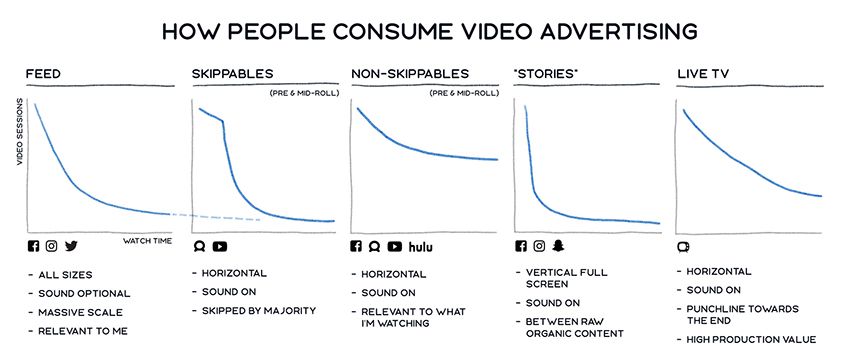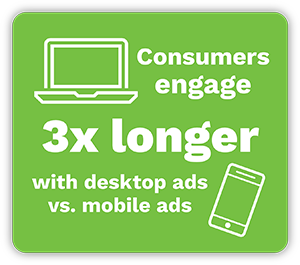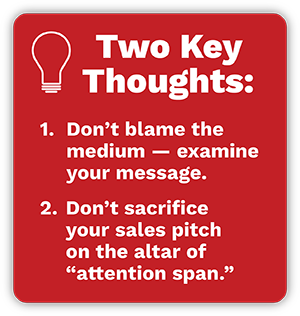5 Mobile Marketing Truly True Truths & To-Dos
Bill Spink Creative That Sells, Digital Direct Marketing, Response Marketing, Trends and POVTo uncover winning creative direction, it pays to dig a level (or two) deeper than the infographic
Making sure you are getting the best advantage of emerging consumer media use is a primary concern for marketers. If this trend feels familiar, you’re in good company: 1) You pick up a Latest & Greatest digital trend or insight from a webinar or infographic. 2) You try it out. 3) And … nothing changes.
… Did you fall victim to Digital Marketing Fake News? Was it more like Stephen Colbert-esque “Truthy-ness in Mobile Marketing?” Actually, maybe a bit of both. The way many soundbite factoids are presented in infographics, e-books, etc., can easily lead your team astray in their never-ending quest to boost results.
The Key: What you really need to know is often hidden behind the soundbite. Case in point: A recent email quoted some really attention-getting and thought-provoking facts. Fortunately, it also included links to deeper content. I clicked around. Did some homework. Got the full story. And uncovered valuable insights … often with a significantly different slant than the quick factoid implied.
Here’s what deeper digging and ruminating discovered …
Truthy Mobile Marketing Factoid #1: “Attention Spans Are Shorter Than Ever.” The full story is that the eye-catching “Attention Span” blurb was based on a narrow bit of Facebook data regarding viewing videos via mobile media. A look at the complete data, shared in the adjacent charts, show that (no duh) people are busy when they are looking at skippable video in mobile media … yet they remain willing to sit still longer to view content in other context.
 Charts from: Facebook Business.
Charts from: Facebook Business.
The quick factoid implies people simply have developed a shorter attention span — an insight with implications on all communications in all channels. But that’s not the real story; and not even touched on in the actual data.
Looking into those charts in the deeper links to source data, note the significant difference between “feed” and ”stories,” versus “non-skippable” and “live TV.” Apparently, folks are still hanging in significantly longer for some content. And these new media results aren’t so very different from an “old school” TV ad maxim that viewership is all about the first 3 seconds.
Then poking into other links, we’re reminded it’s not just about video versus other media: People’s interaction varies depending on the viewing device. Research of 9,000 participants cited in The Wall Street Journal, using eye-tracking and EEG monitoring, showed consumers engage 3x longer and react more slowly to ads on desktop, versus a mobile experience. Hmm (again)?
Running with sound bite Attention Span data would be like ADHD on your creative team’s part.
The True Takeaway: Be sure your creative executions work faster … in faster moving media. Like 1 second quick. Or even faster for some on-phone executions — more on that mobile “blink factor” when we get to Fact #3. When you’re deeper in the sales funnel, in a slower medium, you can confidently slow down, and give that consumer the detail they desire. In short, create for the channel and consumer: All media is not created — or viewed — equally.
Deeper Insight Takeaway #1— are attention spans changing, really? The thing is, people have never wanted to spend time reading “marketing.” Digital media just let them act on their “skip” impulses a lot faster. The distinction is important.
Turn the dial on the Advertising WayBack Machine to 1923 and revisit advertising pioneer Claude Hopkins’ book “My Life In Advertising.” Claude shares an argument he had with a client over whether people would read a full-page ad. Apparently, even back in the Roaring 1920s, people’s attention spans were questionable.

Claude’s answer to “will they read?” was an A-B creative test. Results clearly showed consumers would indeed hang in, read long copy and respond! Provided the copy — i.e., content — was laser-focused on their self-interest, packed with specific meaningful benefits, plus had a compelling offer. Speed ahead to present day, and we’d all likely confess to searching out and spending time on websites, reading blog posts, reviews, and videos to get all the details on a considered purchase. We still read copy. If it matters to us.
So a key point: If you’re not gaining consumer attention, don’t hide behind “new media.” Examine your message. Make it meaningful. And don’t waste time — but do not sacrifice the power of a relevant full sales story on the altar of “attention span.” Give your prospect some of your attention, too. Hang in with them and complete the sale. Which brings us to …
Deeper Takeaway #2 —those first seconds may actually be secondary to reaching your goal! Those precious few seconds get a lot of our attention as creative marketers. And of course, you must get a consumer’s attention to have them see, view, or read your sales story. But in complete, frank transparency: We often don’t really care about getting the majority of people’s attention most of the time.
It’s true. On behalf of our R&R clients — that’s Revenue & Response-driven clients; distinct from Awareness and Brand-building clients — we’re only really charged with gaining and keeping the attention of a specific, targeted audience who is likely to respond and buy.

At DMW, marketers engage us to attract and motivate qualified, targeted prospects and move them through their sales funnel. Essentially their marching orders to us: “I don’t need KPIs tracking huge numbers of people who eyeball my ad, or even digest every second of content. Show me solid leads and closed sales!”
So, yes, we need to get prospects to look in the first place. But it’s not about packing those precious first seconds with “made-you-look” creative gimmicks. That would be a serious no-no on our part as direct marketers. Our goal is to capture — and keep — attention with meaningful, benefit-loaded messaging, captivating qualified consumers with relevant self-interest, even while realizing we have less time to do it than ever before.
On to Mobile Marketing Truly True Truths #2, 3, 4, and 5 … Okay – enough about “Attention Span.” And thanks for your attention hanging in with this topic, in what turned into a substantial post on Truth #1 of 5!
The next 4 items are all important, valuable, and the “deeper dive” on each may even strike you as quite surprising:
- #2 — The highest-responding mobile Facebook Ad layout factor
- #3 — Just how quickly mobile ad readers are bailing on you
- #4 — Where your brand is best positioned in mobile marketing
- #5 — How to position your CTA for optimal response
While our blog editor’s red pen is ending this entry at this point, be assured the sequel post is loaded into the DMW Blog queue, will be posting shortly, and includes all remaining 4 points in their entirety.
In the meantime, additional marketing insight and actionable marketing ideas are at your fingertips. Click one of the following links now to get our team’s most recent posts on Digital Direct Marketing, insights on DRTV and Video, and perspectives on Creative That Sells.
More urgently, If you have a response marketing challenge you’d like DMW to help you tackle ASAP, please contact us here.